You ever bite into something so light and sweet it feels like eating a dream? That’s the magic of Cotton Candy Clouds. Imagine the delicate fluff of spun sugar, pastel swirls that melt the instant they touch your tongue. It’s not just dessert—it’s nostalgia on a stick. A fairground memory, bottled whimsy, the taste of laughter and long summer nights. And yes, you can make it right in your own kitchen.
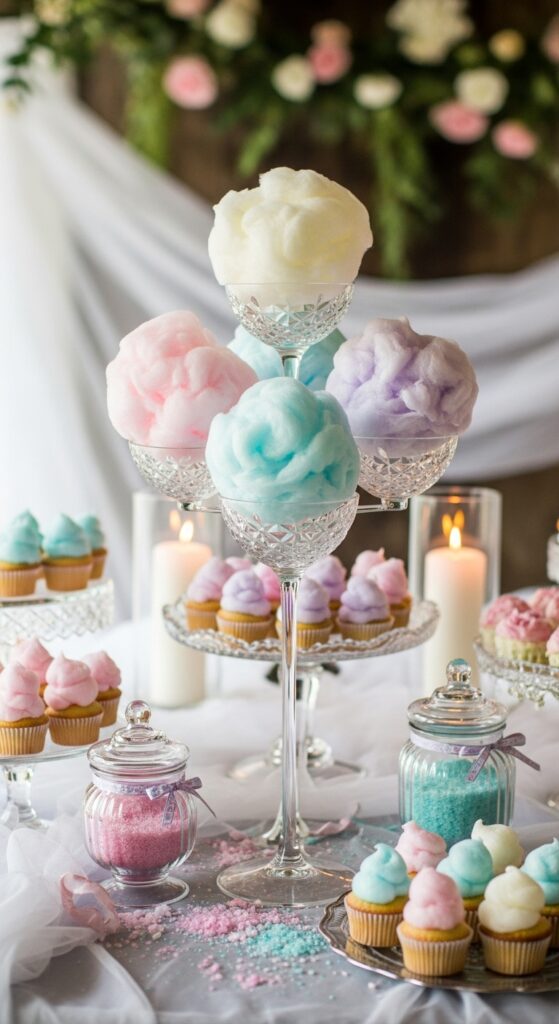
Why It’s Special
Cotton Candy Clouds aren’t your everyday treat. They sit at the intersection of art and chemistry—pure sugar transformed into silky filaments of sweetness. It’s simple, but also oddly poetic. There’s a bit of science, a bit of showmanship, and a whole lot of joy. Every culture has its version of sugar magic—Persian pashmak, Turkish pismaniye, Chinese dragon’s beard—but cotton candy? That’s the Western carnival hero. It’s fun, dramatic, and instantly nostalgic.
What makes it special at home is that you control everything: the flavors, the colors, the textures. You can keep it classic pink vanilla or turn it into lavender honey clouds, matcha mist, or salted caramel swirls. Once you start, it’s hard to stop experimenting.

Ingredients & Substitutions

Making Cotton Candy Clouds doesn’t take much. It’s mostly sugar and a little science. But the details matter.
Granulated sugar: Use pure white cane sugar for best results. Brown sugar or raw sugar can work, but they’ll caramelize faster and give a toffee flavor (not bad, just different).
Flavored extract: Classic vanilla works beautifully. Or try strawberry, lemon, rose, or even bubblegum for that carnival vibe.
Food coloring: Gel colors are ideal—they don’t water down the sugar mix. Just a drop or two is enough.
Corn syrup (optional): Helps prevent crystallization when melting sugar for DIY versions. If you’re using a home cotton candy machine, you can skip it.
Citric acid (optional): Adds a tiny tang that balances sweetness. Just a pinch does wonders.
Substitutions:
- Vegan? You’re in luck—cotton candy is naturally vegan unless you use flavorings containing dairy.
- Sugar-free? Try isomalt or erythritol, but be aware: they melt differently and need careful temperature control.
- No artificial colors? Beet juice, spirulina, or turmeric give gorgeous natural hues (and you’ll feel fancy doing it).
Expert tip: Use superfine sugar if your machine allows—it melts smoother and spins lighter. And store your mix in an airtight container before spinning, since sugar loves to pull moisture from the air.
Step-by-Step Instructions
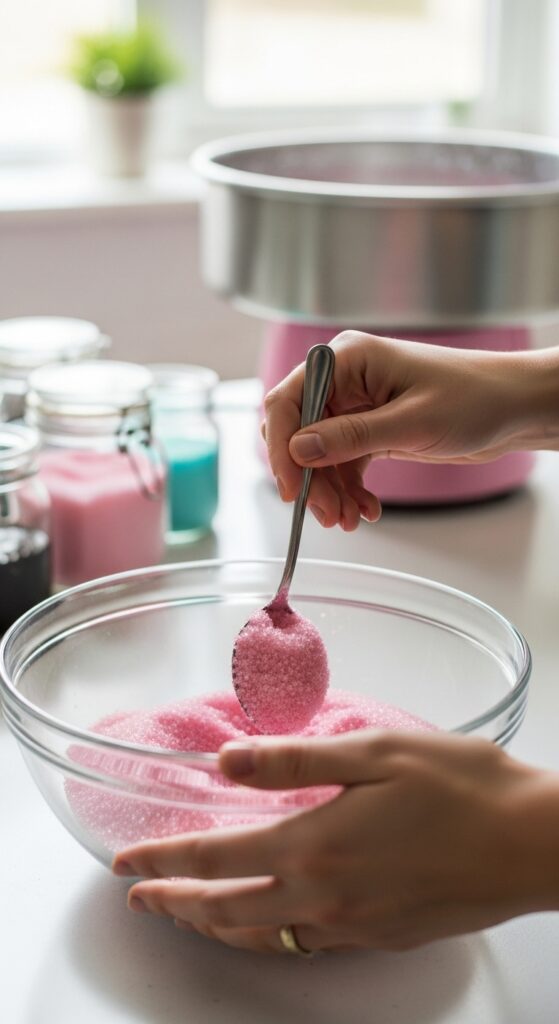
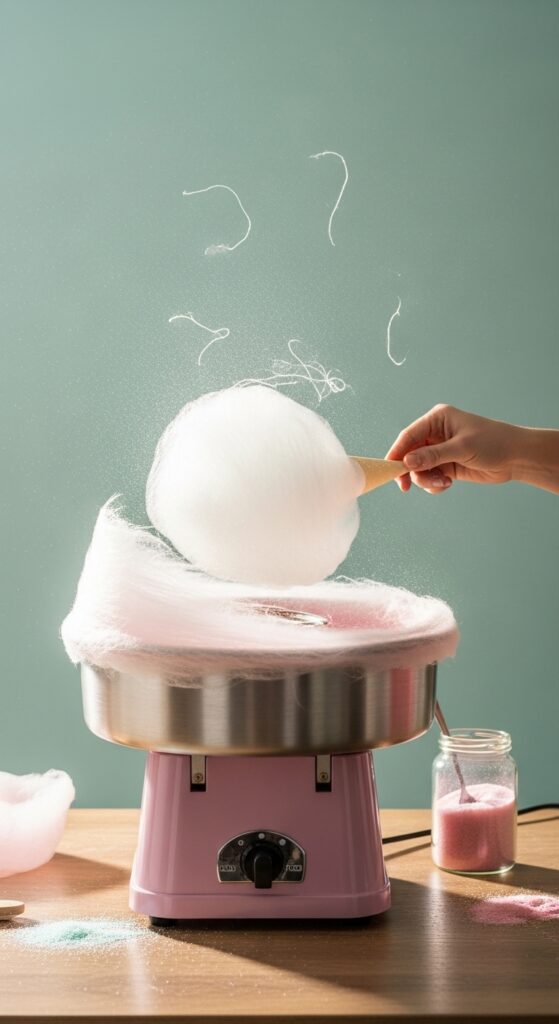

Alright, time to spin some magic. Whether you’re using a home cotton candy maker or going old-school stovetop, the process is easy once you get the rhythm.
- Prep your station. You’ll want a clean, dry surface and no humidity. Moisture is cotton candy’s worst enemy—it melts the sugar before it even hits the cone.
- Preheat your machine. Let it run for 5 minutes so it’s nice and hot. If you’re using a DIY stovetop method, bring your sugar syrup to 320°F (160°C)—that’s the hard crack stage.
- Mix your flavor and color. Combine sugar with a drop of extract and color in a bowl. Stir well until the hue is even.
- Load the machine. Pour in about a tablespoon of sugar mix. The moment it heats, it’ll liquefy, then suddenly—like magic—threads of candy start forming.
- Spin and gather. Hold a paper cone (or even a chopstick) vertically and rotate it around the machine’s bowl, catching the strands as they fly. Keep twirling until you’ve built a cloud of your desired size.
- Shape it. Lightly compress or fluff the edges to make those dreamy pastel domes. Don’t over-handle—warm hands make it collapse.
- Serve immediately. Cotton candy starts melting within minutes, especially in humid air. You can store it in airtight containers for a few hours, but fresh is unbeatable.
Variations:
- Spicy: Add a pinch of cayenne or cinnamon sugar for a sweet heat.
- Floral: Try rose or lavender essence for a delicate perfume.
- Citrus twist: A few drops of lemon extract give a bright finish.
- Vegan & natural: Use plant-based colors and pure essential oils instead of synthetic flavorings.
Common mistakes:
- Don’t overcrowd the machine—too much sugar burns easily.
- Avoid humid environments.
- Don’t touch the sugar threads directly when hot—they harden fast and can sting.
Cooking Techniques & Science

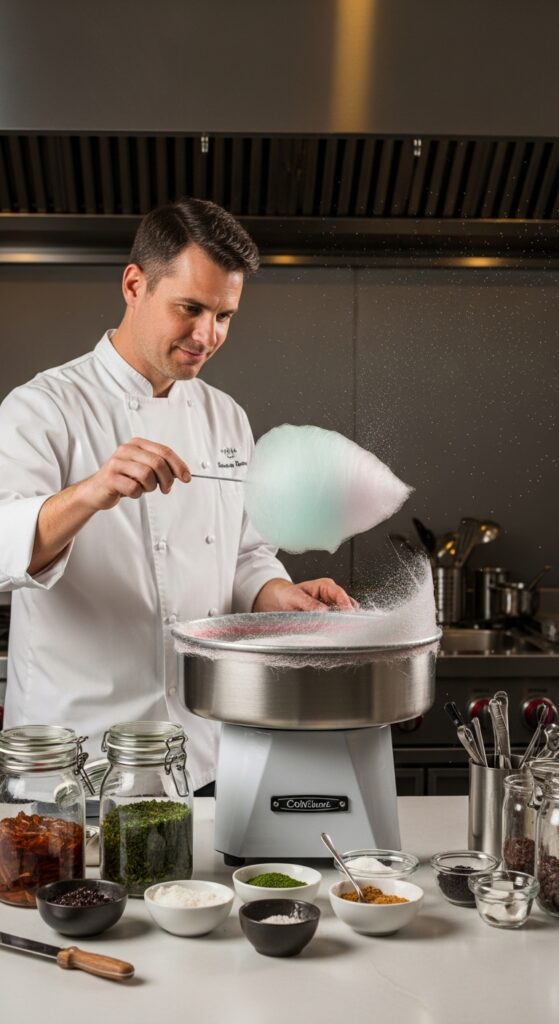
Here’s where the magic meets the method. Cotton candy is pure sugar heated until it liquefies, then spun at high speed so centrifugal force flings it through tiny holes. As it hits the air, it cools instantly and solidifies into ultrafine strands. That’s the transformation from crystal to cloud.
The reason sugar works so perfectly is because of its molecular structure—it melts cleanly, caramelizes predictably, and forms long threads before crystallizing. The trick is keeping it dry and evenly heated.
If you’ve ever wondered why you can’t just whisk melted sugar, here’s why: agitation at the wrong stage causes crystallization—tiny grains that ruin that silky texture. The machine’s spin is controlled chaos—precise enough to stretch sugar without letting it regroup into crystals.
Useful tools:
- Home cotton candy maker: Worth it if you plan to make this often. Compact, safe, and easy.
- Digital thermometer: Crucial for stovetop versions. Sugar stages are sensitive—a few degrees make a big difference.
- Paper cones or sticks: They’re not just for fun—they help catch and shape the sugar as it spins.
Pro tip: Always let the machine cool before cleaning. Sticky sugar hardens fast, but warm water dissolves it like a charm.
👉 Recipe Card: Cotton Candy Clouds
Ingredients:
- 2 cups granulated sugar
- 1 tsp flavored extract (vanilla, strawberry, etc.)
- Food coloring (a few drops)
- 1 tbsp corn syrup (optional, for stovetop)
- Pinch of citric acid (optional)
Instructions:
- Preheat your cotton candy machine for 5 minutes.
- Mix sugar, extract, and color in a bowl.
- Add 1 tbsp of sugar mixture to the machine.
- Spin the cone to gather the strands as they form.
- Repeat until you’ve got a full, fluffy cloud.
- Serve immediately or store in airtight containers for up to 6 hours.
Prep time: 10 minutes
Cook time: 5 minutes per batch
Servings: 6–8 small clouds
Nutrition (per serving):
Calories: 105 | Sugar: 27g | Fat: 0g | Protein: 0g | Carbs: 27g
Serving & Pairing Suggestions
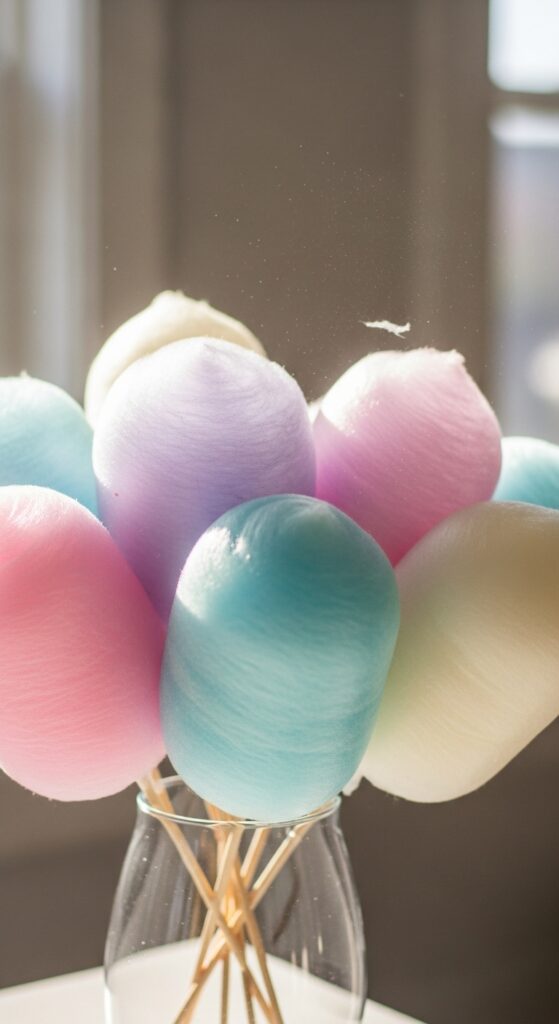

Cotton Candy Clouds are already eye-catching, but you can elevate them even more. Use them as toppers for cocktails, cupcakes, or milkshakes. Picture a tall glass of sparkling lemonade with a pink puff floating on top—it slowly melts, sweetening the drink with a touch of showmanship.
They make stunning dessert garnishes too. A sprinkle of edible glitter, a drizzle of caramel, or a few sugared petals can turn them into centerpiece-worthy creations. For events, stick them on skewers and display them like bouquets.
Pairing ideas? Think balance. Cotton candy is pure sweetness, so contrast it with tart flavors or rich textures:
- Lemon sorbet or yogurt parfaits
- Bitter espresso or dark chocolate desserts
- Bubbly drinks like prosecco or kombucha
And for kids’ parties—oh, the possibilities! Mini clouds on cupcakes, rainbow layers, even cotton candy ice cream sandwiches. It’s edible art with zero rules.
Conclusion
There’s something beautifully childlike about spinning sugar into air. It’s ephemeral, delicate, fleeting—but that’s the charm. Cotton Candy Clouds remind us that food doesn’t always have to be serious. Sometimes, it’s pure joy in sugar form.
Whether you’re crafting it for a celebration, experimenting with colors, or just chasing a sweet memory from the fair, making it yourself gives you full creative freedom. Try new flavors, play with shapes, and don’t worry about perfection—clouds aren’t meant to be identical.
A final tip: serve it fresh, serve it fast, and enjoy the smiles it brings. Because by the time your guests take a bite, that airy sweetness will vanish like a dream—and that’s exactly how it’s supposed to be.
FAQs
1. Can I make cotton candy without a machine?
Yes! Melt sugar with corn syrup until it reaches 320°F, then use a whisk to flick strands onto parchment paper. It’s messier but surprisingly fun.
2. How do I stop cotton candy from melting?
Keep it away from humidity. Store in airtight containers with silica gel packs if needed, and serve in a cool, dry space.
3. What’s the best sugar for cotton candy?
Refined granulated sugar gives the best spin. Coarser or brown sugars burn faster and may clog machines.
4. Can I make it in advance?
A few hours ahead, sure. Overnight, not ideal—it loses volume and gets sticky. Always spin close to serving time.
5. How do I make multicolored cotton candy?
Make small batches in different colors, then layer them on the same cone for rainbow swirls. It’s part science, part performance, and completely irresistible.
Cotton Candy Clouds are proof that sometimes, the simplest ingredients—just sugar, color, and air—can become something magical.

Selena is an experienced lifestyle blogger and the voice behind many of Cozy Toned’s inspiring posts. With a passion for mindful living, home styling, and everyday wellness, she shares practical tips and fresh ideas to help readers live beautifully and intentionally.